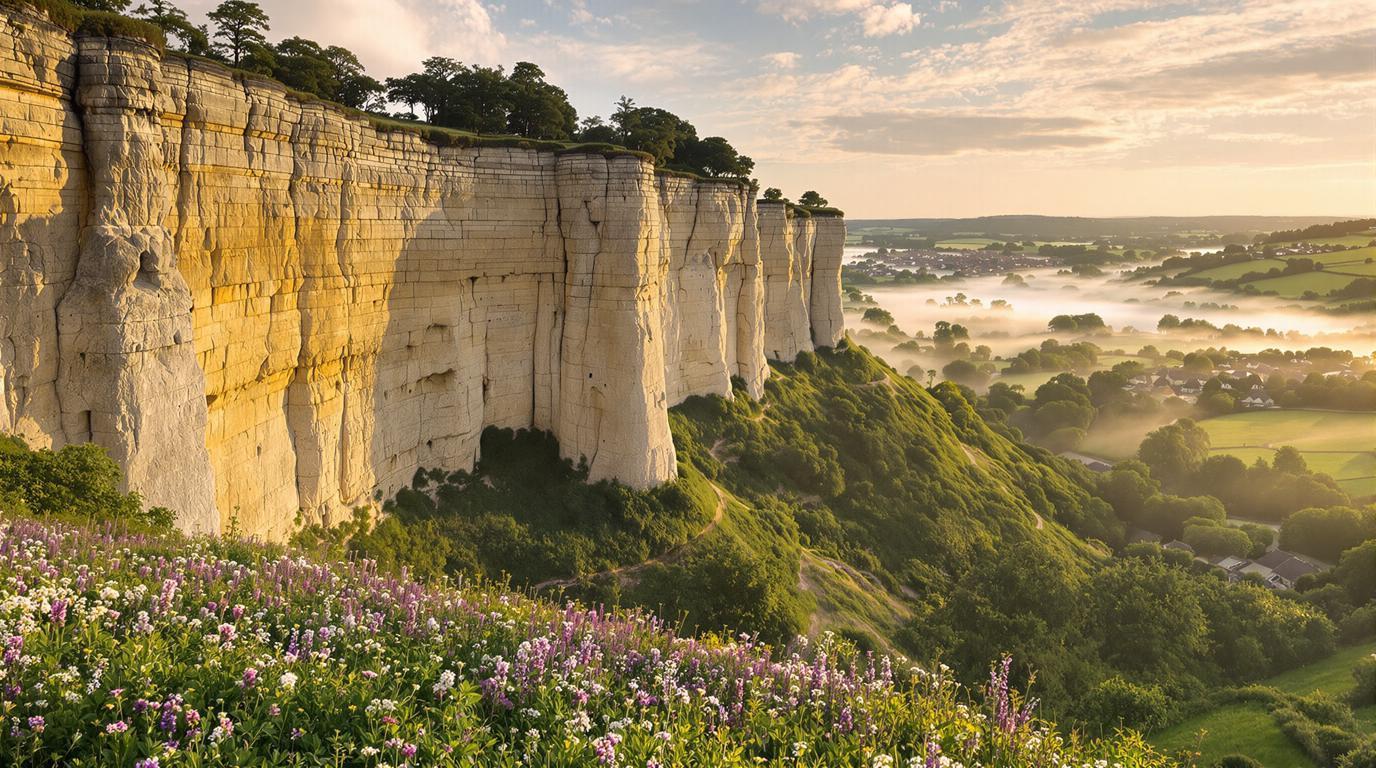The 787-square-mile limestone plateau holds secrets that most British travelers never discover. Three years ago, I found myself standing on Cleeve Hill’s 330-meter summit, watching morning mist rise from springline villages below, realizing I’d stumbled upon England’s most underrated natural sanctuary. While millions flock to Tuscany’s crowded hills, the Cotswolds’ Jurassic limestone belt stretches for 60 miles through six counties, harboring geological wonders and authentic rural culture that locals fiercely protect.
This isn’t another quaint English countryside story. The Cotswolds represent Britain’s largest National Landscape, where 139,000 residents live among 210-million-year-old oolitic limestone formations that create a living museum of scarp-and-dip geography. Every springline village tells a story of human adaptation to geology, where medieval settlements followed water sources emerging from limestone aquifers.
What struck me most wasn’t the golden stone architecture everyone photographs, but the profound sense of geological continuity. This landscape has been quietly shaping British identity for millennia, offering an authentic alternative to Europe’s overcrowded destinations.
The geological secret that defies Mediterranean comparisons
How 210-million-year-old limestone creates modern sanctuary
The Cotswolds’ Jurassic oolitic limestone belt represents one of England’s most intact geological formations, creating the dramatic western scarp that faces the Severn Valley while gently dipping eastward toward Oxford. Unlike Tuscany’s clay hills or Provence’s chalk plateaus, this limestone landscape supports unique springline ecosystems where underground water emerges to sustain both wildlife and human settlements. The result is a 25-mile-wide corridor of grasslands, beechwoods, and valleys that function as natural climate refugia, maintaining cooler temperatures even during Britain’s warmest summers.
The forgotten art of reading limestone landscapes
Local geological guides taught me to recognize the subtle signs of this ancient seabed: the way dry stone walls follow natural limestone breaks, how villages cluster around spring emergence points, and why certain meadows bloom with rare orchids found nowhere else in England. The Chiltern Hills offer similar limestone heritage, but the Cotswolds’ scale and preservation remain unmatched across Britain’s escarpment country.
Hidden authenticity that defies mass tourism
The springline villages tourists never find
While Instagram crowds descend on Bourton-on-the-Water, villages like Guiting Power and Temple Guiting remain largely undiscovered, their populations barely reaching 300 residents each. These settlements represent authentic England: working farms, medieval churches, and pub conversations that haven’t changed in decades. The strategic placement of these villages along geological springlines creates natural boundaries that limit development and preserve rural character.
Why locals prefer their limestone sanctuary to European alternatives
Margaret, a Winchcombe resident for forty years, explained why she’s never felt the need to visit Tuscany: “We have everything here—ancient history, stunning landscapes, and peace. The difference is authenticity.” Her sentiment reflects a broader local pride in landscapes that function as living communities rather than tourist attractions. The limestone regions of France offer similar geology, but the Cotswolds maintain their agricultural heritage without compromising rural integrity.
The exclusive experience locals don’t want tourists to discover
Secret trails through ancient earthworks
The Cotswolds contain over 600 scheduled ancient monuments, including Neolithic long barrows and Bronze Age settlements, accessible only through unmarked footpaths that locals use for daily walks. These archaeological sites, scattered across limestone downs, offer solitary encounters with 5,000 years of human history. The best-preserved sites lie within the escarpment’s steepest sections, where modern development proved impossible.
The seasonal wildflower displays that rival Mediterranean meadows
July brings the Cotswolds’ most spectacular natural display: limestone grasslands exploding with orchids, harebells, and butterflies that thrive in calcium-rich soils. These meadows, protected within the National Landscape designation, support species compositions impossible in Mediterranean climates. The Appalachian highlands offer similar biodiversity, but the Cotswolds’ limestone specialization creates unique ecological communities.
Insider access and local secrets
The perfect timing for authentic discovery
Visit during July’s peak wildflower season, when limestone meadows reach maximum diversity and walking conditions remain ideal. Early morning exploration reveals the landscape’s geological drama: mist rising from valleys, springwater reflecting golden stone, and the profound silence of ancient escarpments. Avoid weekends in popular villages, but embrace the working agricultural landscape that continues to shape this remarkable sanctuary.
Travel Note: The Cotswolds’ geological authenticity becomes most apparent during quiet weekday mornings, when you can actually hear water emerging from limestone springs and witness the landscape functioning as a living ecosystem rather than a tourist destination.
Frequently Asked Questions
How does the Cotswolds’ limestone geology compare to Tuscany’s landscapes?
The Cotswolds’ 210-million-year-old Jurassic limestone creates fundamentally different landscapes than Tuscany’s younger clay and sandstone hills. The limestone’s porosity supports springline ecosystems and creates the region’s characteristic golden stone architecture, while Tuscany’s geology produces the famous terracotta colors and different vegetation patterns.
What makes the Cotswolds’ 787 square miles unique among British landscapes?
The Cotswolds represent Britain’s largest intact limestone escarpment, combining geological significance with exceptional cultural preservation. The scarp-and-dip landscape, springline settlements, and traditional agricultural practices create a unified 60-mile corridor that functions as both natural sanctuary and living heritage landscape.
When should I visit to experience the most authentic Cotswolds atmosphere?
July offers optimal conditions for experiencing the Cotswolds’ natural character: wildflower meadows at peak bloom, clear walking weather, and agricultural landscapes actively managed. Early weekday mornings provide the most authentic encounters with the geological and cultural heritage that defines this remarkable English sanctuary.
The Cotswolds’ limestone secret lies not in its picturesque villages, but in its geological continuity—a 210-million-year-old foundation that continues to shape both landscape and culture. As Mediterranean destinations struggle with overcrowding and heat, this English sanctuary offers authentic encounters with limestone country that few travelers truly discover. The question isn’t whether the Cotswolds rival Tuscany’s beauty, but whether you’re ready to experience England’s most profound geological and cultural heritage.
